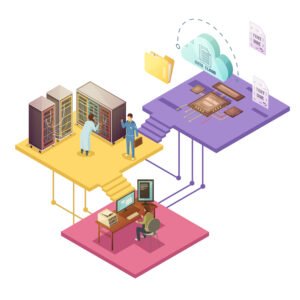Introduction
The modern advancement of electrical systems require real-time data monitoring and control, thus making need for substations automation even greater. Through the use of SCADA systems (Supervisory Control and Data Acquisition), operators have the ability to automate substations, which enables remote access for asset management, performance monitoring, and fault response. With the integration of key technologies such as PLCs and RTUs, along with SCADA software systems, the substations become intelligent nodes within the power grid which enhance the performance of energy systems by making them safer, more reliable, and smarter.
This blog explains the revolutions SCADA systems bring to electrical substations, covering SCADA architecture and communication protocols, cyber security, smart grid interfacing, and projected developments. If you are looking to modernize your power systems through SCADA software solutions, this blog will provide you with comprehensive insights.
SCADA Architecture: Key Components That Power the System
The SCADA system is a powerful framework that combines hardware and software to monitor, control, and automate industrial processes. Its architecture is designed to handle vast amounts of data from geographically dispersed assets, making it essential in industries like energy, manufacturing, water treatment, and transportation. At the core of a SCADA system lies a robust network of interconnected components, each with a specific role in ensuring smooth operations and real-time decision-making.
Let’s break down the primary components of a SCADA system architecture:
-
Supervisory Controller
As the main unit of a SCADA system, supervisory controller manages all activities within the system. It handles interactions with peripheral devices by processing data from field devices, and also sending control commands to conduct operations.
-
Remote Terminal Units (RTUs)
Remote Terminal Units (RTUs) are field devices that look after control at one particular location. They collect data from various sensors, consolidate the data, and then send the information to the supervisory controller. They also receive control instructions, and carry them out at the location.
-
Programmable Logic Controllers (PLCs)
Programmable Logic Controllers (PLCs) are industrial computers used to control and automate processes. They interact directly to sensors and actuators, control commands on the basis of the internal logic that is programmed.
-
Human-Machine Interface (HMI)
HMI is the portion of the SCADA system where the operator interacts with the SCADA system. Things such as data, alarms, and trend information are available in real time allowing an operator to make an informed decision.
-
Intelligent Electronic Devices (IEDs)
IEDs are sophisticated control devices that accomplish control, protection and monitoring functions simultaneously. They are widely used for electrical substations, control as well as in power distribution systems.
-
Network Management Server
The network management server monitors and manages the SCADA’s communication framework. The server also ensures that all data moves correctly from one part of the monitor system to the other.
-
Communication Components
Communication components enable data transfer between the field devices and the supervisory controller. They comprise both wired and wireless networks, communication protocols, and system interfaces.
-
Programming Language
The logic and algorithms for controlling the SCADA system are developed using specific programming languages. Some common ones are ladder logic, structured text, and function block diagrams.
Communication Protocols in SCADA Systems: Making Substations Talk
A SCADA system’s intelligence hinges on how well it can communicate. In the substations where data exchange and command execution need to occur in real-time, communication protocols are the enabling layer for seamless cross-device communications. These protocols take care of RTU, PLC, IED, and other field device and central supervisory controller interface operational reliability, data security, and operational efficiency.
Let’s look at the most prominent communication protocols used in SCADA systems implemented in electrical substations:
IEC 61850 – The Standard for Substation Automation
IEC 61850 is a modern and very adaptive protocol; it has been specifically crafted for substation automation. Unlike older protocols, it aids faster exchange of data as well as interoperability of devices from different manufacturers. It facilitates protection, monitoring, and control functions in SCADA systems with minimal delay, and hence is perfect for critical environments.
- Tailored for electrical substation ecosystem
- Permits higher levels of device integration and automation of processes
- Provides quick access response times and Large Scale data exchange capabilities
DNP3 – Trusted in North American Utilities
DNP3 (Distributed Network Protocol) is an extensively adopted communication standard in the utility industry, particularly in North America. It was specially designed to resolve issues with reliability in data communication and is known for its use in low bandwidth, high latency environments.
- Commonly adopted in SCADA systems for water, electricity and gas utilities
- Ensures reliable and time-stamped data delivery
- Provides event driven data communications and data buffering
DNP3 can best be applied in old SCADA systems situated in remote substations where sturdy and low maintenance systems are needed.
Modbus – The Classic Industry Protocol
One of the well-known and oldest protocols in the realm of industrial automation is Modbus. Although its structure is simple, it works well in integrating devices such as PLCs, RTUs, and HMIs in a SCADA system regarding communication.
- Easy to use and has robust adoption
- Perfect for interfacing with control systems, sensors, and meters
- Exists in serial (Modbus RTU) and Ethernet (Modbus TCP) formats
Even though Modbus does not offer speed or security features like those found in IEC 61850 or DNP3, smaller and simpler SCADA systems rely on it due to its low complexity and high interoperability with other devices.
Why Protocols Matter in a SCADA System
Selecting the right communication protocol will ensure all components SCADA systems will work seamlessly together irrespective of manufacturer brand or device hardware version. Protocols like IEC 61850, DNP3, and Modbus do not only allow data to be exchanged between devices but also help in better automation, intelligent decision making, and swift response times in substations.
The right selection of protocols greatly influences the efficiency and flexibility of SCADA systems, whether modernizing an older substation or constructing a new one.
Data Acquisition & Monitoring in SCADA Systems
A modern SCADA system collects and monitors data to fully utilize real-time information within the substations. It gathers pertinent data including voltage, current, frequency, and the health status of the equipment from sensors, RTUs, PLCs, and then sends it to the central supervisory controller.
With the use of Human Machine Interfaces (HMI), operators visualize the data instantaneous, identifying abnormalities and making decisions right away. With real time data visibility, faster responses to any faults are enabled, grid reliability is improved, and energy distribution is made more efficient.
With components like historical data logging, event alerts, and performance evaluations, a SCADA system not only monitors but enhances the long-term performance of the grid. It processes raw data and actionable insights, keeping substations smart, agile, and efficient.
Remote Control & Automation in SCADA Systems
One of the most powerful capabilities of a SCADA system is the remote control and automation of substation operations. Through secure communication interfaces, operators are able to carry out vital functions, such as breaker operations, relay resets, or fault isolation, to name a few, from outside the site.
This remote control feature greatly improves the speed at which emergencies can be responded to and reduces manual handling altogether. In case of a fault, the SCADA system autonomously isolates the affected section, reroutes power, and issues alerts automatically in real-time to assist in avoiding outages and equipment damage.
Remote SCADA functionality also enables automated scheduled switching, load balancing, and maintenance performed based on prevailing conditions. As substations undergo digitization, these functions will streamline operations while increasing safety and reducing costs.
With the addition of remote switching and automated functions, SCADA systems modernize traditional substations into intelligent, self-correcting, energy distribution nodes.
Cybersecurity in SCADA Systems: Protecting Critical Infrastructure
As the level of digital connectivity increases, the SCADA system has become a prime target for cyber-attacks due to its importance in the energy, water as well as in the manufacturing sectors. Since the SCADA system manages sensitive infrastructures, even a single cyber-attack can cause catastrophic outages, system failure, disable critical equipment, or pose dangers to public safety.
Some of the common security threats include:
- Unauthorized remote access
- Malware and ransomware attacks.
- Internal malicious or impersonated users due to poorly managed permissions or insider threats.
- Vulnerabilities in legacy components of SCADA systems
To mitigate these cybersecurity challenges, modern SCADA systems should incorporate a comprehensive suite of cybersecurity SCADA components offer critical defense capabilities such as:
- Network safeguards like segmentation that prevents control systems access from public or enterprise networks.
- Security and precautionary barriers, both firewalls and IDS, active surveillance, and restriction.
- User access and authentication based on multi-layered, multi-role structure (MFA).
- Software maintenance lifecycle enforced, undermined patches of outer-system recognized defenses gaps (vulnerabilities).
- Protection of all sections conversations between devices at the edges and central controllers through datastream encryption.
A strong cybersecurity posture hinges on continuous refinement rather than a single integration. Moreover, effective safeguarding strengthens operational resilience and supports industry regulatory compliance.
Fault Detection & Alarm Systems in SCADA Systems
One key benefit of a SCADA system is the early detection of faults and immediate triggering of alarms to avert possible system failures. In real-time detecting faults in equipment such as substations, where even the smallest problems can be very big, is very important to keep the grid in the right position and protect the useful life of the equipment.
The SCADA system continually checks critical parameters such as voltage, current, frequency, and even the state of the breakers. If the set limits are breached, the SCADA system will raise alarms and self-log the event. Alarms set are used as primary triggers for the “decide and act” process and as such will be classified into different levels of severity.
Other advanced features of SCADA systems which aid in alarm management are:
- On the spot fault announcement using HMI
- Graphical record of all electrical faults for investigation purposes
- Light and sound signals for the identification of system operators
- Self-control of faulty sections to enable quick restoration of service
In conclusion, with easy identification and faster response to system infractions enhanced productivity stems from the reliability of power systems for the users.
SCADA Systems & Smart Grids: Powering the Future of Energy
The smart grid has become a cornerstone of contemporary electric power systems, serving as a critical infrastructure during the ongoing transition towards a sustainable and more decentralised power system. In this context, a SCADA system is essential for the integration of intelligence, flexibility and efficiency in modern smart grid technologies.
Smart grids depend on real time interaction with the users empowered by modern communication technologies. SCADA systems give communications together with real monitoring, telemetry control and analytical systems computation (application systems) enhance proactive interventions changes readiness.
- Here’s how smart grid operations are enhanced by SCADA technology:
- Real-time monitoring and data-driven dynamic load balancing
- Automated detection of outages and rerouting of power, restoring service at record speeds
- Integration of wind, solar, and battery storage with seamless operation
- Live metrics paired with historical data for trend-based predictive demand analysis
- Distributed Energy Resources (DERs) control enhances grid stability
SCADA systems have automatic controls which allow utilities to monitor power demand, making them effective in helping utilities provide a reliable source while also reducing emissions. They make the grid smart, as well as automated for surpassing clean energy goals while also making it more reliable.
SCADA Systems: Key Advantages & Common Challenges
In the implementation of a SCADA system, numerous operational frameworks such as optimization of operations, manning of field-based functions, and infrastructure management is automated. This is beneficial to water treatment facilities and electric substations. Like most powerful new technologies, there is a set of challenges associated with SCADA Systems.
Advantages of SCADA Systems
-
Real-Time Monitoring & Control
A SCADA system facilitates the immediate assessment of equipment activities and permits prompt interventions to resolve any issues.
-
Operational Efficiency
Enhanced Operational Productivity Systems are more efficient because the automation and remote access come at lower labour costs and reduced requirement for manual activity
-
Predictive Maintenance
SCADA systems assist in the acquisition of data continuously, which makes it possible to predict equipment breakdowns, thus saving businesses money in repairs and extending the life of assets.
-
Data-Driven Insights
Effective planning and energy management can be achieved with smart planning and management powered by the analysis and logging of historical data.
-
Enhanced Safety
Protection of the equipment and the operators is enhanced through the use of automated alarms and fault detection systems.
Challenges in SCADA Implementation
-
High Initial Investment
The need for personnel with expertise, software and hardware makes the establishment of a complete SCADA system quite costly.
-
Integration with Legacy Systems
The integration of new SCADA systems with existing older ones is often difficult and requires special solutions.
-
Cybersecurity Risks
Without proper protection, SCADA systems are vulnerable to cyberattacks that can compromise operations.
-
Need for Skilled Experts
A detailed understanding of programming, networking, and control systems is required for effective configuration and maintenance of SCADA systems.
The challenges posed by these factors are easily resolved when there is a well-planned strategy and expert advice provided on investment and operations.
Future Trends in SCADA for Substations
As the energy industry continues to progress, so does the demand for SCADA systems. This is particularly evident in the modernization of substations, which are now becoming smarter and more automated. The following are the primary forces driving the evolution of SCADA systems in substations:
Cloud-Based SCADA
Integration with the cloud enhances collaboration and teamwork through improved remote access, as well as patching and uploading data into the system on a need-to-have basis. This brings customization into the SCADA system, bringing its all-in cost further down.
AI & Machine Learning
SCADA systems not in use yet will have AI integrated into them for the purpose of doing automatic predictive maintenance, anomaly violation, and smart automatic machines, which will simplify tasks that previously relied on humans.
Edge Computing
Substation operations triggered by critical events can benefit significantly from real-time data sourced computation. SCADA systems with edge computing capabilities will offer instantaneous command executions and actions to be performed.
Enhanced Cybersecurity
The modern world is often under constant threat from outside viruses. IT SCADA is considered one of those systems that processes sensitive information. Incorporating powers of AI, blockchains to manage data, and integrating parameters that require a certain level of trust will further modernize cyberspace.
IoT & Smart Devices
Integration with IoT sensors and smart IEDs allows SCADA systems to gather real-time data, enabling richer ensure more efficient control at the substation level.
Self-Healing Grids
Advanced SCADA configuration has the power of enabling substations to automatically isolate faults, reroute power, and restore service without human intervention.
Digitization marks the future of substations, and SCADA systems remain at the forefront of that transformation. With the incorporation of smart grids, advanced automation, and modern analyses, SCADA is evolving—it is paving the path.
How Zealinx Empowers Substation Automation with SCADA
For Zealinx, active performance in providing SCADA engineering services for the energy industry covers electrical substations, power plants, and even the oil and gas sectors. Beyond industry knowledge and experience, we offer:
- Tailored SCADA system design and integration.
- Advanced and cyber-secure software for SCADA applications.
- Automated real-time control monitoring for critical assets and substations.
- Protocols implementation (IEC 61850, DNP3, Modbus).
- System design with cyber security measures.
- Maintenance services and systems optimization
We do not simply provide software, but complete SCADA systems that are guaranteed to lower operational costs while increasing reliability and preparing your infrastructure for the dynamic changes of the future.
Conclusion
In any case, the modern SCADA system is more than just a tool used to enhance functionality—it is the driving unit of new-age substations. SCADA systems facilitate real-time monitoring and remote control automation as well as the integration of smart grids. Very active systems are needed to ensure operational safety, efficiency, and reliability in infrastructure. The right SCADA systems will allow operations to be automated while drastically cutting down maintenance and repairs for newly built and upgraded substations.
Zealinx offers automation systems for utilities and plant operators in the power, energy, oil, and gas sectors. We provide full-service CADAs including design, configuration, deployment, and cybersecurity. For custom solutions, contact Zealinx today.
FAQ
1. What is a SCADA system and how does it work?
A SCADA (Supervisory Control and Data Acquisition) system is an integrated software and hardware solution for real-time monitoring, control, and automation of industrial processes.
2. Why is SCADA important in substations?
Through SCADA systems, substations are able to monitor equipment, detect faults, perform remote operations, and interact with smart grids, which greatly enhance safety and efficiency.
3. What industries use SCADA systems the most?
Power and energy sector heavily depend on SCADA, including in substations, power plants, and oil & gas operations. In manufacturing, it is less common unless bespoke control systems are needed.
4. What are the key components of a SCADA system?
Supervisory Controllers, RTUs, PLCs, HMIs, intelligent devices, communication networks, control and data analysis software make up the primary structural components.
5. How can Zealinx help with SCADA implementation?
For the energy and industrial sectors, Zealinx offers comprehensive SCADA engineering services, including design and integration, protocol configuration, and cybersecurity.





